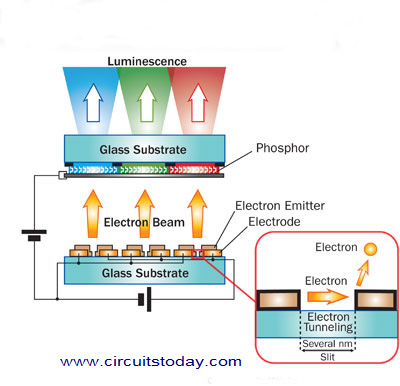The Surface Conduction Electron Emitter Display [SED] is almost similar to a CRT, and hence is easier to explain when compared to a CRT display.
Although a CRT display is huge and heavy, the picture quality, viewing angle and also visual artefacts are very much appreciable. But, when the combination of the picture quality of a CRT and the size of a plasma display is introduced in one component, a SED TV is obtained. The SED TV can be built to a huge size with excellent picture quality.
A CRT display has an electron gun which fires electrons onto a phosphorus screen. The screen contains pixels, which when hit upon begin to emit light. To get a colour display, mainly three types of electrons are used, which each strike different phosphors for red, green and blue. Thus the image is formed by the combination of the glowing points and the peculiar reception of your eyes.
Working of SED TV

The SED TV contains many millions of small CRT’s which are together called as surface-conduction electron emitters (SCE). These SCE’s mainly contain a big layer of carbon with a gap on its centre. One part of the carbon layer is connected to the positive electrode, while the other is connected to the negative electrode. These SCE’s are arranged in the form of a matrix inside an SED TV. Like a CRT, each SCE is assigned a particular composite colour to one pixel of the picture. In a CRT, the electrons are directed onto the screen to create an image horizontally. But, in an SED, all the SCE’s are activated at the same time and thus the picture is created simultaneously on the phosphor screen. The screen is given a positive charge and it attracts the electrons from the other side. Like a CRT, the vacuum space is present in the SED as well. This vacuum keeps the SCE’s on one side and the screen on the other.
When the pixels on the screen begin to glow, our brain starts to join these lights and make a mental image. When it happens at a fast rate, our brain senses the image as moving. Almost sixty pictures are created per second and unlike a CRT, each line is not created many times a second, but the whole picture is created.
This type of a display has better contrast because, the pixels that are not used is shown as black. The screen also has less reflected light because of a colour filter present between the phosphorus and the glass.
Advantages and Disadvantages of SED TV
Although this type of a display was very much competitive as OLED, LCD and Plasma displays, the production of this display has been delayed for no specific reason. Some of the reasons may be the initial production cost and the selling rate is not at all affordable. These TV’s are considered to be the most costly. The power consumption of this TV is also said to be more than any other TV. The advantages include flat screen, light weight, large viewing angle, less blur comparable to CRT and so on.
Here are some useful resources:
TAKE A LOOK : WORKING OF ORGANIC LED (OLED)
TAKE A LOOK : WORKING OF CRT
TAKE A LOOK : WORKING OF PLASMA DISPLAYS

2 Comments
Can someone clarify the disadvantage of cost of SED over LCD and Plasma as mentioned above? I read the followign article a few years back that said that production costs and power consumption would be low for SED TVs.
http://zainlcd.wordpress.com/2008/08/15/sed-surface-conduction-electron-emitter-display-technology/
Can someone clarify the disadvantage of cost of SED over LCD and Plasma as mentioned above? I read the followign article a few years back that said that production costs and power consumption would be low for SED TVs.
http://www.tourmontparnasse56.com/uk/